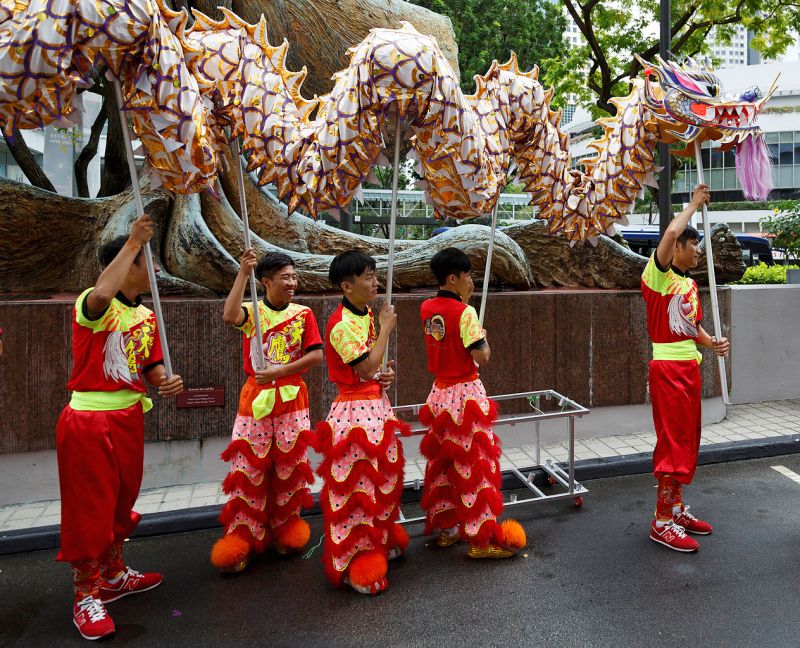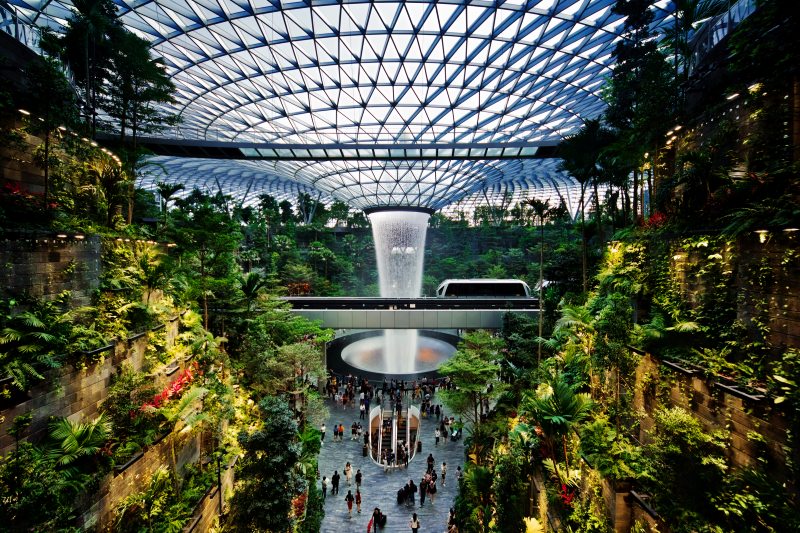Singapore
The city state of Singapore has becomes a successful nation despite its small size. It has been settled extensively by people of Chinese ancestry who form the dominant group. Singapore shares a similar recent history to Hong Kong and Shanghai. It was chosen as a trading port by the English East India Company in the nineteenth century. Singapore is only 26 miles [42 kms] west to east and 14 miles [23 kms] north to south. Its name is derived from the Malay name ‘Singapura’ which means ‘Lion City’. In Chinese it is transliterated as 新加坡 Xīn jiā pō.

The dominant figure in its early development was Sir Stamford Raffles ➚ who arranged its purchase from the Sultan of Jahore 1819 after he had tried and failed to found a new port on the island of Java. Raffles chose an appropriate time because the Dutch East Indian empire was in terminal decline. At the time Singapore was, like Hong Kong island, barely inhabited with only a few Malay and even fewer Chinese. It provided safe anchorage on a vital trade route from India to China and Indonesia and also exported tin and rubber from inland Malaya. By 1826 the bustling town had attracted many more Chinese who began to outnumber the local Malays. The Chinese community were known as Peranakan Chinese ➚ and formed a distinct group with their own traditions which came from settlers in the 15th to 17th centuries mainly from Cantonese, Hokkien and Hakka peoples. Ming dynasty explorer Zheng He visited the port and this early contact bolstered links with China. Later on many people fled here from the Taiping Rebellion and a large number of ‘coolies’ procured by the resident Chinese from China. It was a place where hard work and luck could make anyone comfortably well-off. By 1871 there were 100,000 people half of them Chinese. A long-term British resident wrote ‘It is no exaggeration to say that to these (Chinese people) to a great extent, may be attributed the wonderful progress and prosperity of Singapore’. Most industry was related to trade and shipping. As a measure of the admiration of the British, the local leader Hoo Ah Kay ➚ (aka Mr. Whampoa) was awarded the Order of St Michael and St George in 1876 by Queen Victoria and served on the legislative council. Nowadays the Chinese community has people with ancestral roots from all over China. The population reached 5.7 million in 2019 and in 2017 74.3% considered themselves ethnic Chinese.
As part of the British Empire it formed part the ‘Straits Community’ made up of four possessions along the Malayan straits: Penang Island ➚ (Prince of Wales Island ), Seberang Perai ➚ (Province Wellesley - mainland to east of Island), Malacca ➚ and Singapore. To prevent possible ethnic tensions the different communities (Malays, Chinese and Indians) were segregated within the city. China disputed the status of Chinese people at Singaport as all the ethnically Chinese citizens of Singapore were regarded as citizens of China. This issue led to a dispute over the treatment of Chen Qingzhen in 1854 who was tortured by the Chinese as he was regarded as their citizen but he claimed his birth was in Singapore.

Change came with the Second World War. Britain had built up Singapore as an impregnable fortress that would be the center of defense for its interests in the area. Britain spent $500 million on building up defenses and the largest dry dock in world. The Japanese attacked the city in December 1941 and easily took it by first invading the Malaysian peninsula and then attacking the city from land to the north and not the sea. It surrendered on 15th February 1942 (Chinese New Year) and it was the largest surrender in British history. After Allied victory over Japan, Malaya including Singapore was granted independence in 1963. Tensions between Malay and Chinese people led to the split of the city from Malaya in 1965. The last vestige of British presence left Singapore was when the Royal Navy left the port in 1971.

The People's Action Party (PAP) was founded in 1954 to fight for independence from the UK. After independence it was Lee Kuan Yew ➚ 李光耀 Lǐ Guāng yàoof the P.A.P. who spearheaded the reforms to build modern Singapore. The PAP has remained the ruling party of government since 1968. His party maintained close links with Taiwan rather than the Peoples Republic and Lee became a broker in the talks between the ‘two Chinas’. There are three official languages in the city: Mandarin, English and Malay. Recently English has become not just the normal language of business but the language most used at home, but most people are fully literate in at least two of the languages. Singapore uses the simplified rather than the traditional script.
Back in 1978 Deng Xiaoping was so impressed with Singapore that he ordered top party members to visit the city to learn how a modern city could be run efficiently and prosperously. The training of senior Chinese officials in Singapore has continued up until recent years. It was only after 1990 that formal diplomatic relations with the PRC were normalized. Soon Singapore became a major investor in China's industrial modernization. Singapore became one of the ‘Asian Tigers’ (aka Little Dragons) : Taiwan, South Korea, Hong Kong and Singapore that demonstrated how Chinese people can create prosperous market economies. This success was an important spur to Deng Xiaoping and Jiang Zemin's reforms in China. Chinese President Xi Jinping has said that he admires the way that such a small country a Singapore manages to retain good relations with both the US and China.
According to the World Bank ➚ Singapore is one of the wealthiest places in the world, ranked 3rd in 2019 based on GDP per capita. It has a low crime rate and 12th in the world according to the UN Human Development Index Ranking ➚ 2021. The prime minister since 2004 has been Lee Hsien Loong 李显龙 the eldest son of Lee Kuan Yew who has maintained his father's style of administration that is considered strict but fair.

Singapore has highly regarded green spaces within the city. ‘Gardens by the Bay’ is a large nature park in central Singapore; it includes the largest greenhouse in the world (‘The Flower Dome’) containing a range of flowers from different continents. The first impression of the city by visitors is at the acclaimed airport which has a large ‘Butterfly Garden ➚’ where travelers can relax in a tropical butterfly habitat with a thousand butterflies fluttering among lush vegetation near the ‘Rain Vortex’ waterfall.